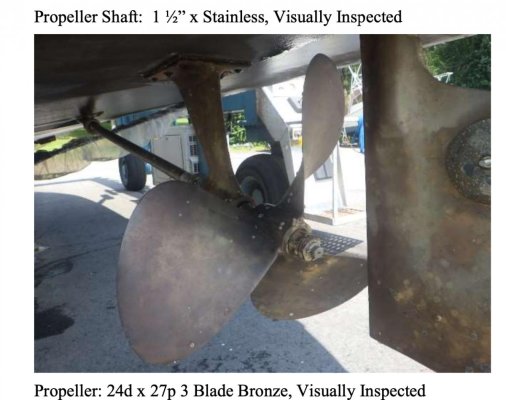Hit small pieces of floating wood and some thin edges can curl enough for a vibration.
Back in the old days when we dug out slips using commercial vessel propeller wash...I would wear blades thin in just a couple years and hitting even clam shells would curl the edges. New/normal props don't and will not deform when worn blades will. Sure there is no exact rule of thumb...but if his IS thin from wear or corrosion, it bears looking at and remedying at a convenient time.
Got LOTS of experience with wearing out running gear and hitting bottom as part of my second career.
According to US Navy engineers and many pros I know...the thin nut goes on first (after the large nut sets the prop and is removed).
The thin nut then goes on and then the big one last.... when torqued, it unloads the forward thinner nut and now the big nut (with more threads) carries most of the load.
While many will say it doesn't matter as so many boats have been going around for years with the big nut first...all I can say is true...it probably doesn't matter but the majority seem to think bug nut last.
https://www.passagemaker.com/channels/propeller-nut-myth-busting
"Contrary to commonly held beliefs, when assembly is complete,
the half-height nut should be against the propeller hub, having been installed first, while the full-height nut is farthest from the propeller hub, having been installed last. The logic for this seemingly counterintuitive approach goes like this: when the first nut is installed and torqued down, it carries all the load or tension. When the second nut is installed against the first nut and it is torqued, much of that load or tension is transferred to the second nut. Thus, it only stands to reason that the second nut (the one that carries the majority of the load), should engage more of the propeller shaft with more threads.
I know for all you gearheads out there this appears to be heresy or worse, and you are wondering if I’ve lost my nut-and-bolt mind. When I first began proliferating this information several years ago, it was met with the hue and cry of many in the boat-owning and marine repair and boatbuilding communities, proclaiming it sacrilege, barbaric, and just plain stupid. Some even claimed that I had intentionally misled folks to drum up business for myself and my colleagues in the industry by propagating a spate of lost propellers. Even today, whenever I share this approach, the skeptics come out of the woodwork.
Rest assured, not only is this approach one I wholeheartedly endorse, but it’s also backed up with good engineering and it’s endorsed by propeller manufacturers, the Society of Automotive Engineers, the American Boat and Yacht Council, the U.S. Coast Guard, and the U.S. Navy. The latter spells this procedure out in excruciating detail in chapter 75 of their sublime (if you like this stuff) NavShipsTechManual (Chapter 075-5.3.4, Fasteners). It can be downloaded as a pdf, courtesy of Uncle Sam; I keep a copy on my iPad for “light” in-flight reading."


